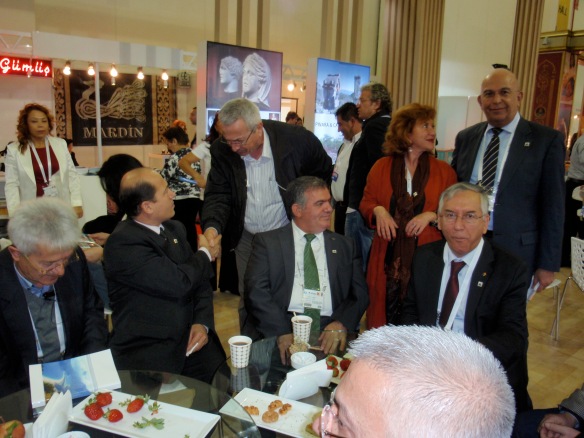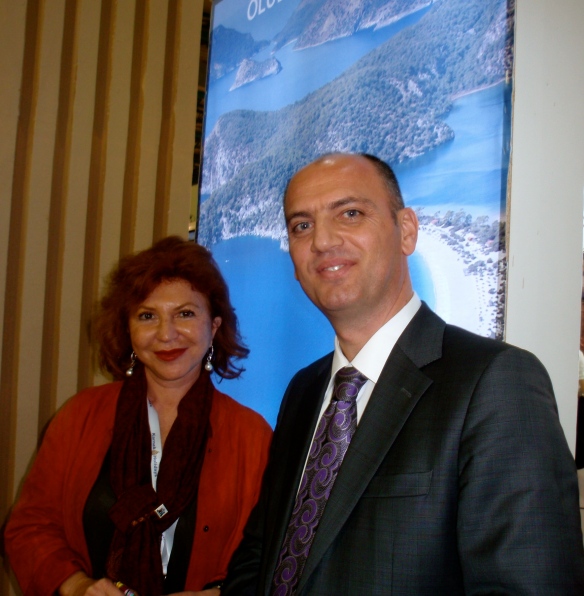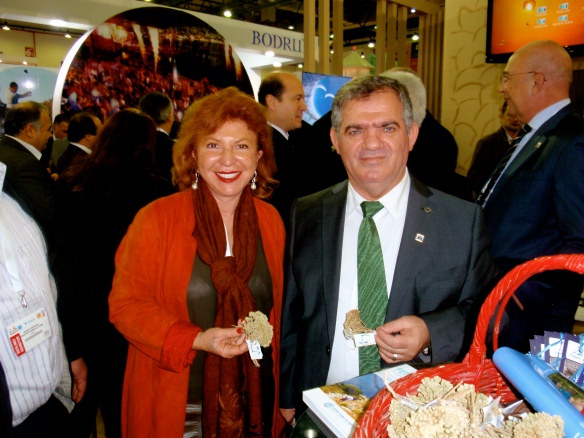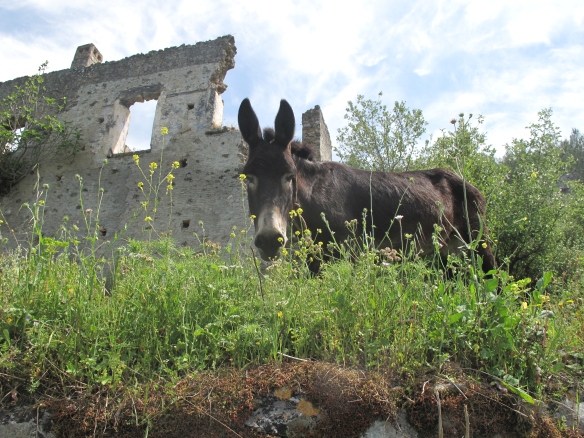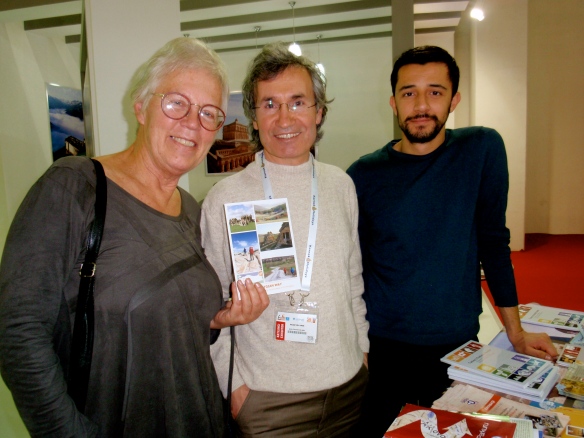This story is written by my dear friend Chris Drum Berkaya, for which many thanks!
Emerging from halls full of dazzling promises of sunshine, entertainment, luxury and holidays into the drizzling grey January rain of Istanbul is a startling but potent reminder of what the business of EMITT is all about: selling the dreams of holidays. EMITT is the 17th East Mediterranean International Travel and Tourism Exhibition which opened on Thursday 23 with a registered 4,500 or more representatives of hotels, agencies, tourism destinations, tourism suppliers, and of 70 countries, congregating at the TÜYAP Fair and Convention Centre on the outskirts of Istanbul. They are there to network and sell their brand and their product, and on the last two days of the trade fair’s four days, they hope to sell direct to the public. It makes EMITT, ranked 5 in 2012, one of the largest tourism and trade fairs in the world.
Fethiye’s representatives are all there, literally under a single roof. Günsenin Günel, owner-manager of the boutique hotel Oyster Residence on the famous Öludeniz beach of Fethiye, and winner of Turkey’s 2012 Skål ‘Oscar’ for her contribution to quality tourism, is emphatic that it is effective for the hoteliers and agents of Fethiye to be there, “Even if you consider just meeting amongst ourselves- it would take me a year to see everyone, yet
here we can gather and discuss issues.” She is busy greeting people at the FETAB (Fethiye Alt Yapı Birliği) co-ordinated stand that represents and promotes all the attractions of Fethiye, Çalış beach and Saklıkent Gorge areas.
Surrounded by columns and decorations inspired by the famous Lycian tomb of King Amyntas that looks down from cliffs above Fethiye, the stand has different desks with staff distributing brochures and answering questions. It is of course a meeting place for Fethiye tourism business people, with Fethiye Chamber of Business, the Chamber of Shipping, the Hoteliers Association and local agents also part of the co-ordinated group.
The local officials, the Fethiye Governor Mr. Ekrem Çelik and the Police Chief Huseyin Kocabıyık, arrive to sit with them in a semi- informal chat, which again Günsenin points out as effective networking “Here we get them away from their offices, and meet and talk socially, and they get to understand us better’.
As FETAB is barely a year old it is vital that the concept of its role as the co-ordinating body for both promoting and improving tourism in Fethiye is well understood. Günsenin says they are getting money back into cleaning the beaches, protecting the bird reserves, encouraging local employment and training. They are also tackling the hard tasks – cleaning up the famous lagoon, and limiting pollution. “We can‘t close our eyes to the pressures on the Lagoon’ she says. She believes that it is important that the beauty of Fethiye is on show, the beautiful nature and simple joys of being out in that nature.
In the past year Fethiye has been represented at world fairs in Holland, Dubai, Moscow and Milan, and the knowledge gained at those events, Günsenin insists, is brought back and shared in FETAB. Things are changing in Fethiye, with the Ministry of Tourism and Culture now working on the long dreamt-of restoration of the ancient amphitheatre and the tombs area, and the Fethiye
Municipality have managed to get an exchange of land areas with the national government to gain the promise of a brand new Museum that will be complement the tombs and old castle area.
Just how fast things are changing was illustrated when the Muğla Province Tourism and Culture Director, Dr. Kamil Özer, arrived at the stand. Discussions moved into high gear on the two topics at the core of the FETAB led push for sustainable tourism: the deserted village of Kayaköy and the fate of the 90km end section of the world famous trekking route – the Lycian Way. At one minute an hotelier is saying that the development of Kayaköy village is ‘just a rumour’. The next minute in the other corner, Dr Özer, flanked by a Ministry person from Ankara, confirms that the previous day’s press release is correct when he says ‘it is in today’s Official Gazette’; that the Kayaköy project has been approved for a tender to be called for restoration of 1/3 of the houses for a 300 –bed accommodation facility, and that 2/3 of the houses (the remainder) will also be renovated for ‘cultural activities’. Some of the different hoteliers and agents are surprised: one Kaya valley boutique hotel manager saying when asked ‘No – no one in the valley has ever been consulted on this’.
The Lycian Way and the new hotel development driven widening of more of the first kilometres of the historical walking path is under discussion at all levels, the Ministry representative confirms, while both she and Dr. Özer assert that everyone’s concerns will be discussed at a meeting of stakeholders in February.
In the main International exhibition hall of EMITT, in a coveted place on the Turkish Ministry of Tourism and Culture’s own stand, is Kate Clow – the woman who in the 1990’s was so inspired by the discovery of ancient pathways and still used village walking paths, that she crusaded for sponsors and marked out the Lycian Way to link the paths right along the magnificently scenic coast of the Tekke Peninsula.
After years of publicising the route and seeing the Way become one of the ten top walks in the world (according to the Sunday Times) she is now Chairman of the new NGO- the Culture Routes of Turkey Society (Kültür Rotaları Derneğı – for more information visit: http://cultureroutesinturkey.com) founded by mostly Turkish members who are passionate about trekking, and who themselves have created new Routes in different parts of Turkey, sometimes supported by local authorities keen to bring a light touch of tourism into their areas.
The brochures and maps, all printed by the Ministry these days, tell their story- the Phrygian Way wanders from Gordion to ancient sculptures of Yazılıkaya past Kutahya: the Kızılırmak Havzası (the great river valley) Gastronomic walking way- created with the Çorum Vali; St.Paul’s Trail from Antalya to the interior at Yalvaç; the Evliya Çelebi way – the Cultural Route for horse riders; the list is a wonderful smorgasbord of routes where the real Turkey can be seen and met with on an activity holiday. Kate states their aims are about sustainable tourism, and cultural understanding. Yet when asked about the developments on the Fethiye side of the Lycian Trail she is pessimistic that the newly legislated expansion of municipalities will see development impinging on neighbouring natural and village areas to the extent that it won’t be possible to start a route near a transport hub/ or town. Once a municipality has a town plan in place (‘İmar Plan’), time and time again a pretty lane or a centuries-old camel/donkey footpath marked as a road on ‘ the plan’ therefore must become a wide thing of concrete and asphalt in the local authorities’ eyes.
Local land owners, speculators and construction companies also have vested interest in opening vehicular ways, and along the coast for hotel development on privately held land. Kate Clow is adamant that the routes could and should be protected by the present mechanisms of the provincial Heritage Protection Boards (Koruma Kurulları) designating protected areas- ‘SIT ALAN’, and locals respecting them. Indeed the Muğla committee had started a review specifically of the Lycian Way, in 2010. ‘It is a case of needing the political will’ states Clow.
Kate Clow insists on remaining positive about the future of the Lycian Way and the long distance trekking routes, not least because of the interest being taken by the Ministry of Culture and Tourism. These days, the ministry and the Governor of Muğla (Vali), Fatih Şahin, are all frequently reported talking about the importance and long-term benefit of cultural tourism in Turkey at both national and international levels. She is also hopeful that, even if local authorities and officials show little interest in protecting Muğla’s cultural heritage, and creating tourism opportunities sensitive to the environment, there are at least being efforts made to sensitively remedy these problems at provincial and ministerial levels.

